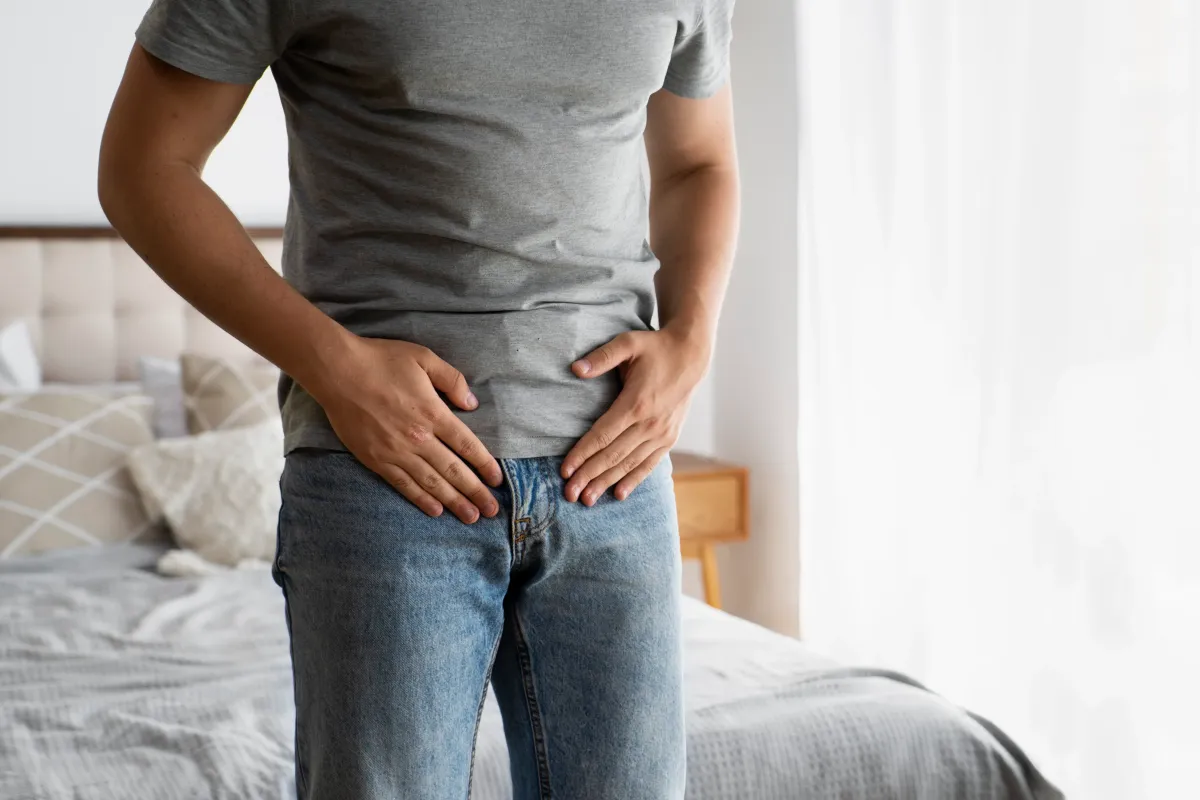Groin Pain Treatment in NYC
Manhattan Physical Therapy

What Is Groin Pain?
Groin pain refers to discomfort felt where the lower abdomen meets the upper thigh. The pain may sit right in the crease, slightly above it, or a bit below. It can appear on either side and may develop suddenly after a specific movement or gradually over time.
Research from sports medicine literature shows that groin pain often involves structures like the adductors, hip flexors, hip joint, nerves, and abdominal tissues—making it one of the more complex regions to diagnose accurately.
While athletes often experience groin issues during sprinting, pivoting, or kicking, non-athletes are equally affected. Everyday movements, prolonged sitting, pregnancy-related changes, or underlying medical conditions can trigger symptoms. When the root cause isn’t identified, the pain may linger or recur, which is why proper evaluation is essential.
Why Does Groin Pain Happen?
Studies in orthopedic and rehabilitation journals highlight that groin pain can originate from multiple systems—musculoskeletal, neurological, urological, or even gastrointestinal. It may begin directly in the groin or radiate from the back, pelvis, or hip due to nerve involvement.
Common Musculoskeletal Causes
Groin strain
Athletic pubalgia (sports hernia)
Osteitis pubis
Avulsion or stress fractures
Other Common Causes
Hernias (inguinal or femoral)
Hip joint issues (labral tears, arthritis, bursitis)
Nerve compression (lumbar disc herniation, entrapment syndromes)
Urological conditions (epididymitis, prostatitis, testicular torsion)
Gynecological causes (ovarian cysts, endometriosis, round ligament pain)
Digestive issues (appendicitis, IBD, diverticulitis)
Secondary groin pain can also occur after procedures like hernia repair or hip replacement, particularly if mesh or surgical sutures irritate nearby nerves.
Source: Cleveland Clinic
Who Is Most at Risk?
International sports medicine research shows that groin injuries account for nearly 10% of all visits to sports clinics, especially among athletes in soccer, hockey, tennis, and basketball. But this is not just an athletic problem.
You may be at higher risk if you:
Make repetitive twisting, kicking, or sprinting motions
Have weak or tight hip or core muscles
Sit for long periods, causing stiffness
Recently underwent abdominal or hip surgery
Have conditions involving the pelvis, urinary system, or reproductive organs
What Symptoms Should You Look Out For?
Symptoms vary depending on the underlying issue and injury severity. Clinical studies on groin injuries categorize symptoms into acute (sudden onset) and chronic (lasting more than six weeks).
You may notice:
Sharp or pulling pain during a specific movement
Swelling or tenderness in the groin
Difficulty lifting the leg
Limping or stiffness while walking
Pain when changing direction, climbing stairs, or rising from a chair
Muscle weakness, spasms, or tightness
Numbness or tingling if a nerve is involved
How Is Groin Pain Diagnosed?
A proper diagnosis requires understanding which structure is irritated—muscle, tendon, joint, nerve, or organ. Because the groin houses multiple systems, research consistently shows that a detailed clinical exam is more reliable than imaging alone.
A typical evaluation includes:
Movement and strength testing to check the adductors, hip flexors, and core
Palpation of the pelvis, abdomen, and hip to identify tender structures
Nerve tension testing if symptoms radiate from the back or hip
Functional assessments such as walking, squatting, and directional changes
Imaging (if needed) – ultrasound for hernias or muscle tears, MRI for hip labrum or stress fractures, X-ray for bone involvement
Accurate diagnosis is especially important because groin pain often has overlapping causes. Research from the British Journal of Sports Medicine shows that nearly 40% of chronic groin pain cases involve more than one structure.
What Exercises Help With Groin Pain?
Below are research-supported exercises commonly used during rehabilitation. These exercises promote strength, circulation, and mobility in the groin and hip.
1. Hip Adductor Stretch
A gentle way to reduce tightness in the inner thigh.
How to do it:
Lie on your back with knees bent
Let your knees fall outward
Press feet together
Hold 30 seconds
Repeat 3 times
2. Lateral Lunge
A dynamic stretch that activates adductors and improves hip mobility.
How to do it:
Stand with feet shoulder-width apart
Step to the side and bend one knee
Keep the opposite leg straight
Return to start
Perform 2 sets of 15 reps each leg
3. Straight Leg Raise
Strengthens the thigh without stressing the groin.
How to do it:
Lie on your back
Keep one leg straight
Lift it about 8 inches
Lower slowly
Perform 2 sets of 15 reps
4. Side-Lying Hip Adduction
Builds adductor strength—the key muscle group in groin stability.
How to do it:
Lie on your side with the top leg in front
Lift the bottom leg up
Lower slowly
Perform 2 sets of 15 reps each side
These exercises are often part of a broader customized program, which may include mobility work, core training, and progressive strengthening.
Source: Healthline
How Physical Therapy Helps
Physical therapy helps groin pain by reducing inflammation, restoring strength, and correcting faulty movement patterns. Research shows adductor-focused strengthening—especially eccentric and isometric work—significantly improves pain, function, and return-to-sport outcomes while lowering reinjury rates. Manual therapy and mobility work ease early symptoms, allowing progressive loading.
Because groin pain often involves multiple structures, multimodal rehab (manual therapy + strengthening + neuromuscular training) outperforms single-method care. Studies report 70–90% recovery when patients follow structured programs emphasizing hip stability, core control, and graded activity. Consistent, supervised therapy remains the most effective non-surgical option for both acute and chronic groin pain.
When Should You See a Specialist?
Seek immediate care if you experience:
Sudden severe groin pain after a pop
Pain accompanied by fever or nausea
Testicular pain or swelling
A bulge in the lower abdomen
Inability to bear weight
Real Stories From People Who Found Relief
“I have experienced groin pain. My pain is related to a combination of total hip replacement (left hip) and a hysterectomy… I strain the groin area usually on the left side and it hurts for a while then goes away. I've had pelvic floor physical therapy with recommendations for stretching that help with all of this.” — From Mayo Clinic Connect discussion
“I had a front groin/hip flexor strain, and my PT felt that my quads lacked elasticity, so she had me doing quad stretches and foam rolling to make it more resilient (note: NOT to lengthen). That worked for me.” — From Reddit: AdvancedRunning thread
“After taking your advice I have been seeing a private physiotherapist which has helped me get back to a level of normality. The dull pain in my right groin has all but gone and I have just started to return to running very slowly.” — From PhysioBase community forum
Call us at (212)-213-3480 to book your appointment today.
What others are saying
Alexander Liu
"Everyone on the team at Manhattan Physical Therapy is super nice and caring. They were able to pretty quickly diagnose my knee and hip problems and immediately put me to work to reduce the pain.."
Henry Myerberg
"You're not just a patient when you come to the Manhattan Physical Therapy. You feel like family there. In particular, Erica with her colleagues John, Lidia and Joe not only fix and improve you physically, they make you feel welcomed and cared for.."
Hakyung Kim
"Everyone is so kind and helpful! my knee and hip pain have improved massively since starting Manhattan PT, highly recommend to anyone. special thanks to Bianca, Lidia, Joe, and John!"
Manhattan Physical Therapy
✆ Phone (appointments):
(212) 213-3480
Address: 385 5th Ave, Suite 503, New York, NY 10016

